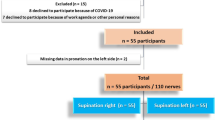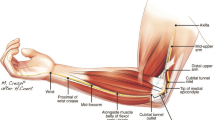Abstract
Purpose
The deep branch of the radial nerve (DBRN) enters the forearm as it passes under the arcade of Frohse. This is the most common entrapment site of the DBRN in the forearm. In this study, we investigated the ultrasonographic reference values for the diameters and cross-sectional area (CSA) of the DBRN at the level of the arcade of Frohse in a healthy sample of the population.
Methods
Sixty-five healthy Caucasian volunteers (130 nerves) were recruited for this study. The reference range [mean ± 2 standard deviations (SD); 2.5th–97.5th quintiles] and the upper limit of the side-to-side difference were determined. The effects of age, gender, handedness, height, and body mass index were examined.
Results
The mean age was 41.8 ± 11.2 years (range 18–75 years). The mean ± 2SD of the CSA was 0.50–1.42 mm2. The upper limit of the normal side-to-side difference was 0.35 mm2. The differences between males and females and between the dominant and non-dominant arms were not significant. The mean anteroposterior and transverse diameters were 0.83 ± 0.13 and 1.23 ± 0.29 mm, respectively. A significant correlation between the dominant-side CSA and age (r = 0.41; p < 0.001) was observed. The correlations between CSA and height (r = 0.19; p = 0.12) and body mass index (r = 0.22; p = 0.07) were not significant.
Conclusion
The measurements obtained in this study are valuable for examining DBRN pathologies using high-frequency ultrasound. The findings showed that age was associated with the DBRN CSA, while gender, height, and body mass index were not.
SOMMARIO
Scopo
Il ramo profondo del nervo radiale (DBRN) entra nell’avambraccio passando sotto l’arcata di Frohse. Questo è il sito di intrappolamento più comune del DBRN nell’avambraccio. In questo studio abbiamo analizzato i valori di riferimento ecografici per il diametro e l’area della sezione trasversale (CSA) del DBRN a livello dell’arcata di Frohse in un campione di soggetti sani.
Metodi
Sessantacinque volontari sani di razza caucasica (130 nervi) sono stati reclutati per questo studio. L’intervallo di riferimento (media ± 2 deviazioni standard (SD); 2,5° -97,5° quintili) e il limite superiore della differenza fra i due lati sono stati determinati. Gli effetti dell’età, del sesso, della dominanza della mano, della altezza e l’indice di massa corporea sono stati esaminati.
Risultati
L’età media era 41,8 ± 11,2 anni (range: 18-75 anni). La media ± 2 DS di CSA era 0,50-1,42 mm2. Il limite superiore della normale differenza fra i due lati era 0,35 mm2. Le differenze tra maschi e femmine, e tra le braccia dominanti e non dominanti non erano significative. I diametri medi anteroposteriore e trasversale erano 0,83 ± 0,13 mm e 1,23 ± 0,29 mm, rispettivamente. Una correlazione significativa è stata osservata tra CSA dominante ed età (r = 0.41; p < 0.001). Le correlazioni tra CSA e altezza (r = 0,19; p = 0,12) e indice di massa corporea (r = 0,22; p = 0,07) non erano significative.
Conclusioni
Le misurazioni ottenute in questo studio sono utili per eseguire valutazioni di patologie del DBRN tramite l’utilizzo di ultrasuoni ad alta frequenza. L’età ha mostrato una associazione con il DBRN CSA; mentre il sesso, l’altezza e l’indice di massa corporea non erano significativamente associati.


Similar content being viewed by others
References
Ozturk A, Kutlu C, Taskara N, Kale AC, Bayraktar B, Cecen A (2005) Anatomic and morphometric study of the arcade of Frohse in cadavers. Surg Radiol Anat 27(3):171–175
Ozkan M, Bacakoglu AK, Gul O, Ekin A, Magden O (1999) Anatomic study of posterior interosseous nerve in the arcade of Frohse. J Shoulder Elb Surg 8(6):617–620
Keefe DT, Lintner DM (2004) Nerve injuries in the throwing elbow. Clin Sports Med 23(4):723–742
Konjengbam M, Elangbam J (2004) Radial nerve in the radial tunnel: anatomic sites of entrapment neuropathy. Clin Anat 17:21–25
Dang AC, Rodner CM (2009) Unusual compression neuropathies of the forearm, part I: radial nerve. J Hand Surg Am 34(10):1906–1914
Sarris IK, Papadimitriou NG, Sotereanos DG (2002) Radial tunnel syndrome. Tech Hand Up Extrem Surg 6(4):209–212
Özçakar L, Kara M, Gürcay E, Onat ŞŞ (2017) Ultrasound imaging for prompt clinical decision making before interventions. Am J Phys Med Rehabil 96(3):e52
Ozçakar L, Malas FU, Kara G, Kaymak B, Hasçelik Z (2010) Musculoskeletal sonography use in physiatry: a single-center one-year analysis. Am J Phys Med Rehabil 89(5):385–389
Nwawka OK (2016) Update in musculoskeletal ultrasound research. Sports Health 8(5):429–437
Babaei-Ghazani A, Roomizadeh P, Forogh B, Moeini-Taba SM, Abedini A, Kadkhodaie M et al (2018) Ultrasound-guided versus landmark-guided local corticosteroid injection for carpal tunnel syndrome: a systematic review and meta-analysis of randomized controlled clinical trials. Arch Phys Med Rehabil 99(4):766–775
Kerasnoudis A, Pitarokoili K, Behrendt V, Gold R, Yoon MS (2013) Cross sectional area reference values for sonography of peripheral nerves and brachial plexus. Clin Neurophysiol 124(9):1881–1888
Cartwright MS, Passmore LV, Yoon JS, Brown ME, Caress JB, Walker FO (2008) Cross-sectional area reference values for nerve ultrasonography. Muscle Nerve 37(5):566–571
Qrimli M, Ebadi H, Breiner A, Siddiqui H, Alabdali M, Abraham A et al (2016) Reference values for ultrasonograpy of peripheral nerves. Muscle Nerve 53(4):538–544
Chen J, Wu S, Ren J (2014) Ultrasonographic reference values for assessing normal radial nerve ultrasonography in the normal population. Neural Regen Res 9(20):1844–1849
Seok HY, Jang JH, Won SJ, Yoon JS, Park KS, Kim BJ (2014) Cross-sectional area reference values of nerves in the lower extremities using ultrasonography. Muscle Nerve 50(4):564–570
Bodner G, Harpf C, Meirer R, Gardetto A, Kovacs P, Gruber H (2002) Ultrasonographic appearance of supinator syndrome. J Ultrasound Med 21(11):1289–1293
Djurdjevic T, Loizides A, Löscher W, Gruber H, Plaikner M, Peer S (2014) High resolution ultrasound in posterior interosseous nerve syndrome. Muscle Nerve 49(1):35–39
Kim Y, Ha DH, Lee SM (2017) Ultrasonographic findings of posterior interosseous nerve syndrome. Ultrasonography 36(4):363–369
Jelsing EJ, Presley JC, Maida E, Hangiandreou NJ, Smith J (2015) The effect of magnification on sonographically measured nerve cross-sectional area. Muscle Nerve 51:30–34
Martinoli C, Bianchi S, Pugliese F, Bacigalupo L, Gauglio C, Valle M et al (2004) Sonography of entrapment neuropathies in the upper limb (wrist excluded). J Clin Ultrasound 32(9):438–450
Cartwright MS, Walker FO (2013) Neuromuscular ultrasound in common entrapment neuropathies. Muscle Nerve 48:696–704
Rota E, Morelli N (2016) Entrapment neuropathies in diabetes mellitus. World J Diabetes 7(17):342–353
Miller TT, Reinus WR (2010) Nerve entrapment syndromes of the elbow, forearm, and wrist. AJR Am J Roentgenol 195(3):585–594
van Rijn RM, Huisstede BM, Koes BW, Burdorf A (2009) Associations between work-related factors and specific disorders at the elbow: a systematic literature review. Rheumatology (Oxford) 48(5):528–536
Lawrence T, Mobbs P, Fortems Y, Stanley JK (1995) Radial tunnel syndrome. A retrospective review of 30 decompressions of the radial nerve. J Hand Surg (Br) 20(4):454–459
Author information
Authors and Affiliations
Corresponding author
Ethics declarations
Funding
None.
Conflict of interest
The authors declare that they have no conflict of interest.
Ethical approval
All procedures performed in studies involving human participants were in accordance with the ethical standards of the institutional and/or national research committee and with the 1964 Helsinki declaration and its later amendments or comparable ethical standards.
Informed consent
Informed consent was obtained from all individual participants included in the study.
Rights and permissions
About this article
Cite this article
Babaei-Ghazani, A., Roomizadeh, P., Sanaei, G. et al. Ultrasonographic reference values for the deep branch of the radial nerve at the arcade of Frohse. J Ultrasound 21, 225–231 (2018). https://doi.org/10.1007/s40477-018-0303-8
Received:
Accepted:
Published:
Issue Date:
DOI: https://doi.org/10.1007/s40477-018-0303-8




